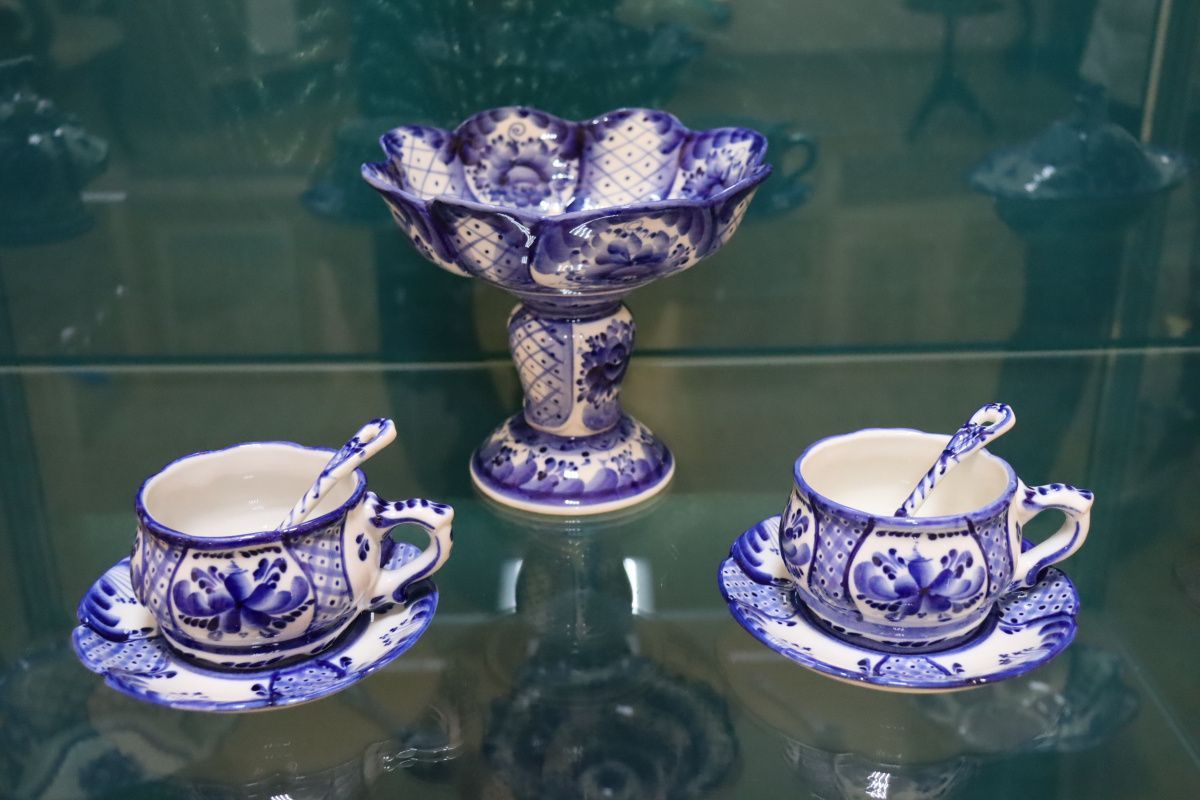Gzhel porcelain has developed as one of Russia’s traditional ceramic arts since the 14th century. Named after the Gzhel region near Moscow, this art initially encompassed various types of ceramics but over time became known for its porcelain decorated with blue designs on a white background. In the 19th century, influenced by cobalt painting techniques from Europe and Asia, it acquired a distinctive style and attracted attention with its elegant, handcrafted motifs.

Gzhel tea set (Photo: Tuapse History and Local Culture Museum)
History
The origins of Gzhel porcelain date back to the Gzhel region, located east of Moscow. Ceramic production in the region is first mentioned in the documents of Grand Duke Ivan Kalita in the 14th century, during which ceramic vessels and everyday items were produced. By the 17th century, the quality of Gzhel clay had been recognized, and at the command of Tsar Alexei Mikhailovich, it began to be used specifically for producing containers for pharmacy and alchemy. The region’s white clay reserves contributed to the development of ceramic art, and in the 18th century, the production of multi-colored glazed ceramics known as majolica began.
From the mid-18th century, Gzhel turned from traditional red clay ceramics to the production of tiles and semi-tiles, and at the beginning of the 19th century, porcelain production gained importance. During this period, ceramics produced in Gzhel included plates, teapots, ink-holders, and decorative objects. The blue and white designs achieved by using cobalt oxide paint became the distinguishing feature of this art.
In the mid-19th century, large-scale production commenced, and many porcelain factories were established in the Gzhel region. However, with the increase in industrialization and the widespread adoption of factory production at the beginning of the 20th century, traditional handmade porcelain production diminished. During the Soviet era, Gzhel porcelain was revived by art historians and ceramic masters, combining traditional motifs with modern production techniques. Today, Gzhel porcelain continues to be produced while maintaining its originality as an important part of Russian culture, both artistically and commercially.
Gzhel made at the Gzhel Porcelain Factory (Source: Гжельский фарфоровый завод)
Production Process and Techniques
The production of Gzhel porcelain begins with processing the high-quality white clay extracted from the region. First, the clay is purified of foreign substances and mixed with water to become homogeneous. Once the clay is brought to a fluid consistency, it is poured into plaster molds to be shaped. These molds are specially designed for different types of porcelain, such as traditional teapots, plates, jugs, and decorative objects. After being removed from the molds, the pieces are dried to become smooth, and any surface irregularities are corrected using a knife or sponge.
After the shaping stage, Gzhel porcelains are decorated using a hand-painting technique. Traditional designs are applied using a black paint containing cobalt oxide. During the firing process, the paint turns blue at high temperatures, revealing the unique aesthetic of Gzhel. The designs typically consist of floral motifs, folk figures, and traditional Russian scenes. Once the painting is complete, the products are coated with a transparent glaze to provide gloss and durability.
In the final stage, the porcelains are fired in special kilns at approximately 1350°C. This process ensures that the glaze fully adheres to the porcelain surface and attains a permanent gloss. As a result of the firing, the blue tones in the designs become pronounced and the porcelain takes its final form. Gzhel porcelain continues to be produced today, preserving its uniqueness through a combination of traditional craftsmanship and modern production techniques.

